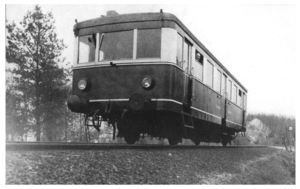Accumulator railcar of the Zschornewitzer Kleinbahn
| Accumulator railcar of the Zschornewitzer Kleinbahn | |
|---|---|
|
Factory photo
|
|
| Numbering: | Zschornewitzer Kleinbahn TW |
| Number: | 1 |
| Manufacturer: | Dessau wagon factory |
| Year of construction (s): | 1934 |
| Retirement: | 1945 |
| Axis formula : | 1A |
| Gauge : | 1435 mm ( standard gauge ) |
| Length over buffers: | 14,610 mm |
| Length: | 13,550 mm |
| Height: | 3,652 mm |
| Width: | 2,970 mm |
| Total wheelbase: | 8,250 mm |
| Empty mass: | 13,550 kg |
| Service mass: | 20,550 kg |
| Top speed: | 60 km / h |
| Hourly output : | 52 kW |
| Range: | 120 km |
| Capacity: | 65 kWh |
| Wheel diameter: | 900 mm |
| Train brake: | Indirect brake , handbrake |
| Control: | Travel switch with dead man's mechanism |
| Seats: | 51 + 6 folding seats |
| Standing room: | 30th |
| Classes : | 3. |
The accumulator railcar of the Zschornewitzer Kleinbahn was a two-axle accumulator railcar of the mentioned railway company . It was procured in 1934 as a one-off from the Dessauer Waggonfabrik in Dessau and was intended to replace steam operation on some connections. It was in operation until 1945.
History and commitment
In order to streamline passenger traffic on the Zschornewitzer Kleinbahn and make it more attractive, the company ordered a railcar from the Dessauer Waggonfabrik . The management of the Kleinbahn, which was subordinate to the then Elektrowerken AG in Berlin , decided on an accumulator railcar. The accumulators were supplied by the then Akkumulatorenfabrik-Aktiengesellschaft . The power supply for battery operation was guaranteed by the Zschornewitz lignite power station, which went into operation in 1915 .
The railcar was delivered on October 12, 1934 and made its first trip to Bitterfeld on October 17, 1934 . In 1934 71,000 passengers use the small train, in 1935 94,000, in 1937 131,000 and in 1940 the transport performance had increased to 287,000 passengers. In 1938, the Dessauer Waggonfabrik delivered another sidecar with an axle base of 5,900 millimeters. Until then, the railcar operated with an existing passenger car from the Kleinbahn.
The area of application of the railcar unit was the section of the Zschornewitzer Kleinbahn from Burgkemnitz to Zschornewitz with school traffic to Bitterfeld. It was also used to carry out special trips, such as theater trains to Dessau, trips to Wörlitzer Park or for company outings. Since the railcar was used on the Reichsbahn line to Bitterfeld, it received an operating license from the Reichsbahn Central Office in Berlin.
The wheel tire wear due to the wide wheelbase and the narrow radius of curvature on the small railway line was high.
On August 24, 1935, the railcar was involved in a collision in Burgkemnitz when the railcar arriving from Zschornewitz crashed into a passenger car parked there.
After 1945 it did not appear in any of the Deutsche Reichsbahn vehicle lists . Like the sidecar, it continued to be used as a passenger car until 1964. The dates of the scrapping are not known.
Constructive features
The railcar was built with a center entry. In this way, the load of the 160 cells of the lead accumulator weighing 5.35 t could be distributed off-center. A smoker / non-smoker compartment was set up for travelers from the middle entrance. The doors at the ends of the vehicle were only used to access the driver's cabs, which were separated from the passenger compartment. The front of the car was divided into three windows. All the doors were sliding; the doors at the ends of the car had cranked windows.
The accumulators were arranged in swap bodies below the car body. These could be sunk down about 450 mm and removed for maintenance. The vehicle had a traction motor , two drive switches, starting and braking resistors and electrical auxiliaries. The traction motor in the cradle bearing had an output of 51.5 kW at 300 V operating voltage. One of the two axles was driven via a simple spur gear with a ratio of 1: 4.77. The driving switches were similar to those on trams and, because the car was used on Reichsbahn tracks , had a dead man's mechanism . They controlled the car in six starting and two operating gears.
The railcar was heated with a stove. It was equipped with a toilet. In terms of color, the railcar was kept in the Reichsbahn colors.
literature
- V. Anton, Günther Fiebig: The Zschornewitzer Kleinbahn GmbH , German Model Railway Association of the GDR, Dessau 1987
- Rolf Löttgers: Battery school bus , in: MIBA miniature railways 12/2000, page 36
Web links
- Website about the Zschornewitzer Kleinbahn
- Website with many photos of the Zschornewitz Kleinbahn railcar
Individual evidence
- ↑ a b c d e Rolf Löttgers: Battery school bus , in: MIBA miniature railways 12/2000, page 36
- ^ V. Anton, Günther Fiebig: The Zschornewitzer Kleinbahn GmbH , German Model Railway Association of the GDR, Dessau 1987, page 62
- ^ V. Anton, Günther Fiebig: The Zschornewitzer Kleinbahn GmbH , German Model Railway Association of the GDR, Dessau 1987, page 23
- ^ V. Anton, Günther Fiebig: The Zschornewitzer Kleinbahn GmbH , German Model Railway Association of the GDR, Dessau 1987, page 65
- ^ V. Anton, Günther Fiebig: The Zschornewitzer Kleinbahn GmbH , German Model Railway Association of the GDR, Dessau 1987, page 69
- ^ V. Anton, Günther Fiebig: The Zschornewitzer Kleinbahn GmbH , German Model Railway Association of the GDR, Dessau 1987, page 67
